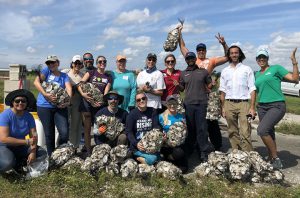Earlier this month, Miami-Dade County hosted its first-ever Coastal Shoreline Restoration module of the Florida Master Naturalist Program. This module focused on restoration principles and approaches for three specific habitats: mangroves, oysters, and salt marsh. The objective of the course is to increase participants’ understanding about living shorelines as an ecosystem-based approach to “softening” the shoreline, rather than building hardened structures.
I co-taught with my esteemed colleague, Water Resource Specialized Agent Dr. Lisa Krimsky. The class totaled 24-hours of instruction time and consisted of classroom presentations, guest lectures, teamwork activities, field trips, and field activities.
The first restoration activity the class participated in involved traveling to the UF/IFAS Tropical Research and Extension Center. Under the direction of Dr. Ashley Smyth, the students worked together to bag and weigh oyster shell, collected from local restaurants and community events. The group totaled 34 bags (over 800 pounds of shell) that will be used for restoration in the Indian River Lagoon. The shell will be put back into the water to create new oyster reefs. The day culminated with tasting of two different kinds of oysters.

Day two’s activities included learning about mangroves and their role in restoration projects in the county. The group traveled to the Deering Estate, where they canoed along the mangrove shoreline and practiced species identification in the field. Guest Gary Milano, formerly of Miami-Dade County Department of Environmental Resource Management spoke about the projects, as well as his thoughts on how restoration efforts should progress.
The final day was perhaps the biggest treat, spent on Virginia Key. The group received a presentation about coral restoration and gardening techniques by two research associates from the University of Miami Rosenstiel School of Marine and Atmospheric Science (RSMAS). Furthermore, they all had the opportunity to connect a living coral fragment to a cement base, that would later be used for restoration. This particular activity was hard to top, but touring the SUSTAIN wave tank came really close. The SUSTAIN lab is RSMAS’s latest technological marvel, generating hurricane-force winds and waves to test how local variables (like coral reefs) will respond in strong wave events, and will help researchers at RSMAS design and deploy hybrid coastal resilience structures (for example, reef balls with outplanted corals on top).
The students ended the last day of class by participating in an active restoration project on Virginia Key, managed by the Frost Science’s Museum Volunteers for the Environment (MUVE) program. After an informative tour of the maritime hammock on Virginia Key, the group planted sea oats, just in time for the plants to be watered by an afternoon shower.
All in all, we were quite pleased with the entire class, as the students often engaged in thought-provoking discussions that benefited all of the members, including we instructors! Dr. Krimsky and I look forward to teaching this course again soon.
For more information on the Florida Master Naturalist Program or to view upcoming courses, please go here: http://www.masternaturalist.ifas.ufl.edu/.
 0
0
